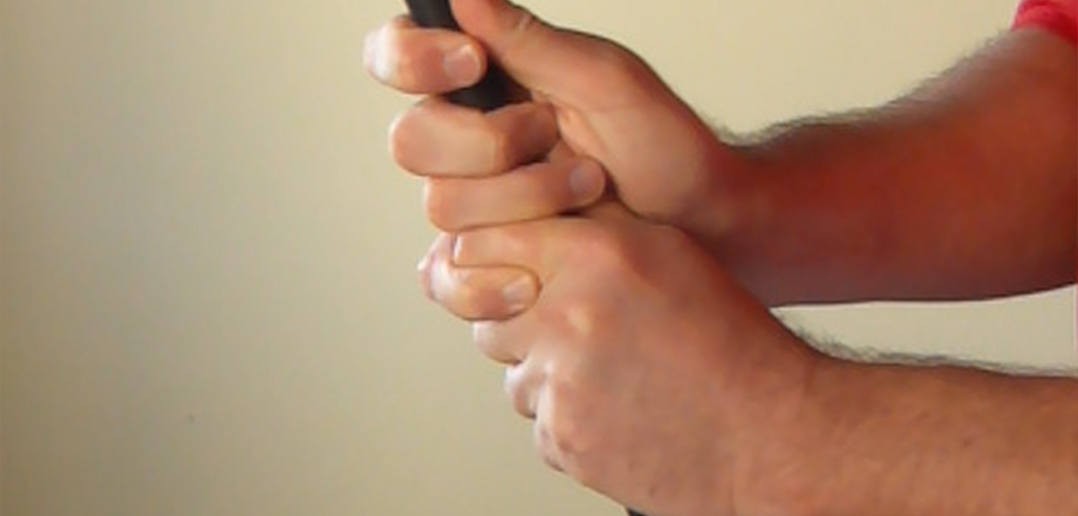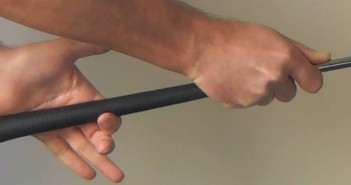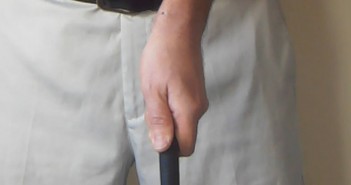This is the fifth in a series of six articles describing the perfect golf grip, starting with Golf Swing 104a – Setup: The Perfect Golf Grip.
Once again, apologies to the lefties, for simplicity these instructions are given for a right-handed golfer.
When you take your grip it is important that the club is secure, that the handle won’t slide around during your swing.
However, it is also crucial that there is no tension in your wrists and arms, which is caused by gripping too hard.
You should think of power in the golf swing as club head speed through impact. Club head speed is created by transferring energy from your body, through your arms and and wrists to the golf club. This energy is transferred through your hands, not created by your hands — you should never try to “muscle” the club with your hands and forearms in a normal full swing, just control the club as you let the energy pass through them.
Think of your wrists as being part of a whip, near the tip. In order to generate maximum speed in the golf club, by “cracking the whip”, your wrists must feel free and loose.
A tight grip firms up your wrists, and thus costs you club head speed and control.
It is surprising just how lightly you can grip the club and still keep it secure. It is important that you try this in order to get a feel for it. Hold a club and slowly adjust your grip pressure, from barely enough to hold the club, up to as hard as you can squeeze it, then slowly back again. Grade these pressures from 1 (lightest) to 10 (tightest). The ideal grip pressure is about a 2 or a 3 — the club should be secure but the wrists and forearms should be loose.
Waggle the club and feel how loose you can make your wrists and forearms while still holding the club securely — foster that feeling in your golf swing.
Most amateurs grip the club way too tightly, usually because they have a poor grip and they are subconsciously trying to gain control. If in doubt, you are gripping the club too tight.
Pressure Points
Most of the pressure on the club handle is applied with the smallest three fingers of your left hand. These fingers have primary responsibility for “holding on” to the golf club, especially through impact.
Because you hold the golf club under the heel of your left hand (the hypothenar eminence), it should feel like you are gripping the club mostly with your little finger.
Your right hand will assist in the control of the club, but not in “holding on” to it to stop it flying away.
Your right hand is responsible for transferring energy through to the golf club, primarily through the proximal phalanges of your middle, ring and index fingers. Because the club is angled slightly across these fingers, and because you form a trigger, the pressure will be felt higher on the proximal phalanx of the index finger, more towards the second knuckle.
Your right index finger is responsible for sensing the lag in the golf club generated in the downswing.
Keep it Constant
You will instinctively increase your grip pressure through impact, everybody does, as the club becomes very heavy.
It should, however, feel as if your grip pressure remains constant throughout the swing.
Never re-grip during your swing. Keep your right thumb on the club (at least until impact), and keep the grip with the smallest three fingers of your left hand secure at all times.
When changing their grip, some students “cheat” unconsciously by re-gripping during their swing. To make sure you’re not doing this, try hitting 2 balls in a row without pausing — if, after the second shot, your club face is misaligned, or the club handle has moved in your grip, you’ve re-gripped.
You can read more about grip pressure, and how to improve and control it, in Soft Wrists and Lighten Up!
If you have any questions or comments about this or other articles on Golf Loopy, please send us an email.
Now let’s put all of this together in Golf Swing Drill 104 – Setup: Taking Your Perfect Golf Grip.




